Mini rebounder balance exercises include one-leg stands, knee-to-chest movements, and lateral leg extensions. Start with gentle bounces, keeping your core engaged and knees slightly bent. Progress to more challenging moves like hinge movements and straight leg kicks as your stability improves. Practice 2-3 times weekly, alternating between controlled stability work and dynamic bouncing sessions. These exercises strengthen your stabilizing muscles and vestibular system, reducing fall risk. The following techniques will transform your balance capabilities.
The Science Behind Rebounding and Balance Training
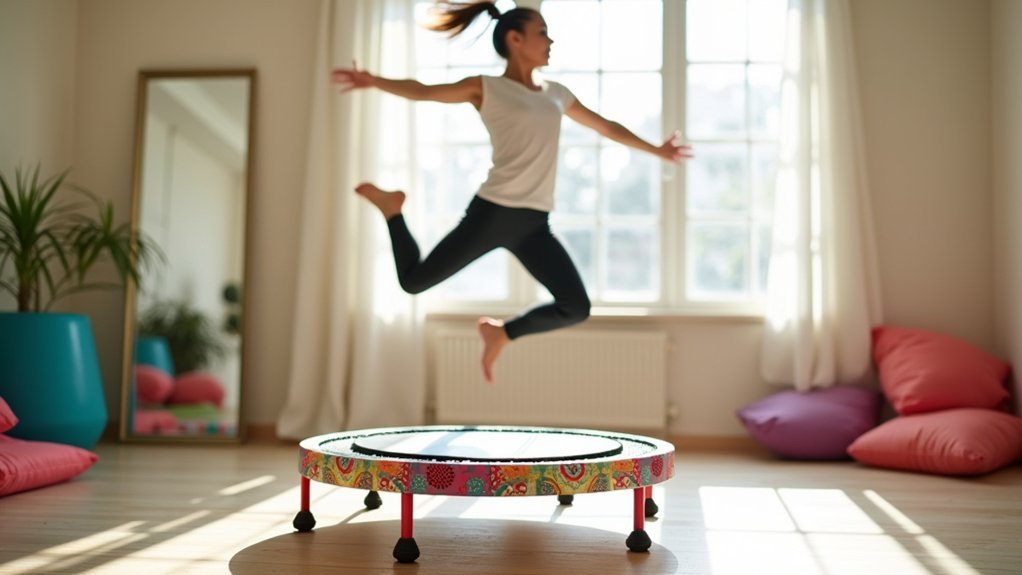
While many fitness enthusiasts focus on strength or cardio training, rebounding offers unique benefits that specifically target your balance systems. When you bounce on a mini trampoline, you’re engaging multiple muscle groups, especially the stabilizing muscles in your core and lower body that are essential for maintaining balance.
Rebounding activates your vestibular system—the sensory network responsible for spatial orientation—forcing your body to make constant micro-adjustments to stay centered. This dynamic balance training improves proprioception, enhancing how your body perceives its position in space. Research shows these improvements notably reduce fall risk in older adults.
The unstable surface of a rebounder challenges your body’s equilibrium more effectively than stationary exercises, creating neural adaptations that translate to better stability in everyday movements.
Essential Warm-Up Techniques for Safe Rebounding
Proper positioning is your first step to safe rebounding, so start with feet hip-width apart and knees slightly bent to establish stability.
You’ll want to activate your core by drawing your navel toward your spine while incorporating deep breaths that naturally coordinate with your arm movements.
Begin with gentle bounces that gradually increase in intensity, allowing your body to adjust to the mini trampoline’s surface before attempting more challenging balance exercises.
Safety First Positioning
Three essential positioning techniques form the foundation of safe mini rebounder workouts. Before you start your minute workout, verify proper foot placement by standing with feet hip-width apart. This simple adjustment makes rebounding the perfect workout for balance improvement, and you’re going to feel more stable immediately.
- Maintain soft knee flexion to absorb impact and reduce stress on your joints
- Engage your core muscles by drawing your navel toward your spine during all movements
- Position your arms comfortably at your sides before incorporating them into exercises
- Keep your gaze forward at eye level to maintain proper neck alignment
Remember to check your positioning frequently throughout your session, especially when fatigue sets in, as proper form prevents injuries and maximizes benefits.
Core Activation Basics
Four essential warm-up movements activate your core before you begin bouncing on your mini rebounder.
Start by standing in a basic position with feet hip-width apart and knees slightly bent. Pull your navel toward your rib cage—this engagement is vital for stability during your workout.
Coordinate arm movements with your breathing as you gently bounce, inhaling as arms rise and exhaling as they lower. This simple technique enhances your body’s coordination while firing up those stabilizing muscles.
A proper warm-up doesn’t need to be complicated—one that’s just five minutes long greatly reduces injury risk while preparing your body for more intense rebounding.
You can perform these core activation exercises as a standalone session or integrate them into longer workouts for consistent stability training.
Gentle Movement Progression
Once you’ve mastered basic core activation, it’s time to introduce gentle movements that prepare your body for rebounding exercises.
Start by standing with your feet hip-width apart, maintaining a neutral spine position. Pull your navel toward your rib cage to engage your core, creating a solid foundation for safe rebounding.
- Coordinate your breathing with gentle arm movements, extending them down by your sides during exhalation and raising them during inhalation.
- Keep a soft bend in your knees to improve balance and reduce impact stress.
- Focus on controlled, deliberate movements rather than speed during this warm-up phase.
- Remember that these gentle progressions can stand alone as effective exercises or integrate into your broader workout routine.
Core-Focused Balance Exercises on Mini Trampolines
Core-focused exercises on your mini trampoline will strengthen your stability muscles while challenging your balance.
You’ll activate deeper core engagement by pulling your navel toward your spine during both controlled movements and dynamic bounce sequences.
Try combining knee-to-chest movements with extended leg variations to maximize your stability benefits while enjoying the gentle rebounding motion.
Core-Engaging Bounce Sequences
The combination of bouncing and core activation creates a powerful stability challenge on mini trampolines.
These dynamic movements target small stabilizing muscles that typically go unengaged during regular floor exercises. You’ll improve proprioception and body awareness while strengthening your entire core system.
- Perform knee-to-chest movements followed by straight leg kicks, maintaining balance through both stationary and bouncing phases.
- Add side leg lifts during your bounce routine to engage obliques and enhance lateral stability.
- Practice the hinge-and-extend technique by bending forward while lifting one leg behind you.
- Repeat these sequences regularly to build lower body strength and improve coordination.
These exercises work together to train your body’s balance systems, creating lasting stability improvements that transfer to everyday movements.
Stabilizing Leg Variations
Four key leg variations can transform your mini rebounder workout into a complete balance training system.
Begin with knee-to-chest movements followed by straight leg kicks, which effectively target your core and improve stability.
Add side leg lifts and back extensions while maintaining your balance to challenge stabilizing muscles and enhance coordination.
Perform each exercise for 30 seconds, alternating between stationary holds and gentle bouncing. This combination maximizes core engagement and balance development.
Focus on one side at a time to guarantee targeted strength building in all stabilizing muscles.
With consistent practice, you’ll notice significant improvements in your overall balance and core strength.
These deliberate movements on an unstable surface create the perfect environment for developing the stabilizing muscles needed for better balance in everyday activities.
Lower Body Stability Movements for Better Balance
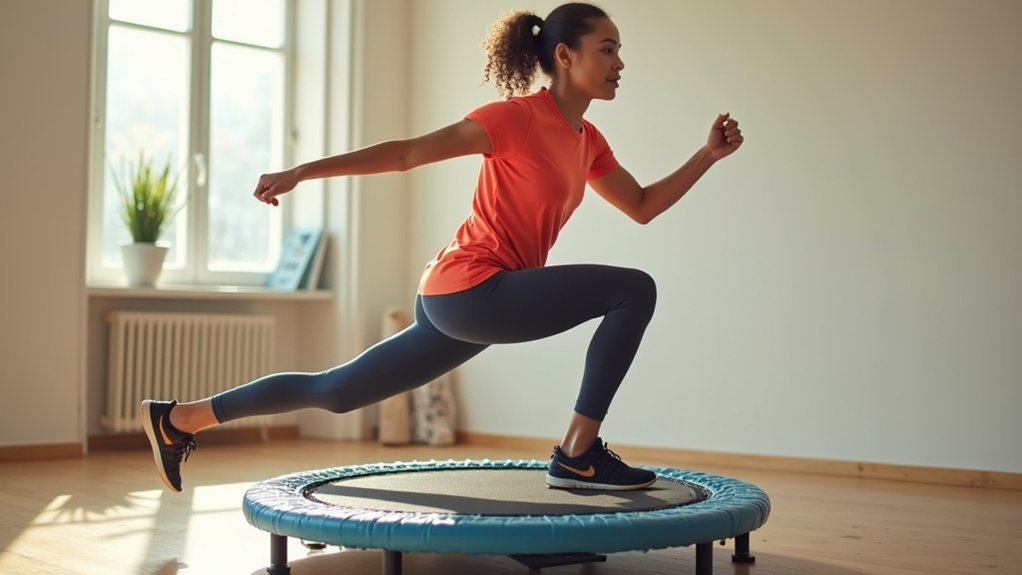
Developing lower body stability directly impacts your balance on a mini rebounder, creating a foundation for safer and more effective exercise.
By focusing on controlled movements that engage your core while challenging your equilibrium, you’ll strengthen the muscles essential for maintaining balance in everyday activities.
- Try knee-to-chest movements while standing on the rebounder to engage core muscles and improve stability through controlled motion.
- Incorporate side leg raises to enhance lateral stability and strengthen hip abductors vital for balance.
- Practice hinging forward while extending one leg behind you to challenge coordination and lower body strength.
- Follow stability exercises with a basic bounce to reinforce muscle memory and improve proprioception.
These movements target stabilizing muscles in your legs and core, greatly reducing fall risk while improving overall balance.
Progressive Balance Challenges for All Fitness Levels
Balance training shouldn’t be limited to advanced exercisers—everyone can benefit from progressively challenging their stability on a mini rebounder. Start with basic one-leg stands and knee-to-chest movements to build your foundation.
As you improve, incorporate more dynamic exercises like leg kicks and lateral movements without letting your opposite foot touch down. Later, add hinge movements by extending your leg behind you while maintaining a flat back.
| Level | Exercise | Progression |
|---|---|---|
| Beginner | One-leg stand | Static → Gentle bounce |
| Beginner | Knee-to-chest | Hold → Small bounces |
| Intermediate | Knee-to-straight leg | Slow → Faster tempo |
| Intermediate | Lateral leg extensions | No bounce → Adding bounce |
| Advanced | Hinge movements | Static → Dynamic balance |
Remember to gradually increase duration and intensity, starting with controlled movements before adding the bouncing element.
Combining Cardio and Balance Work on Your Rebounder
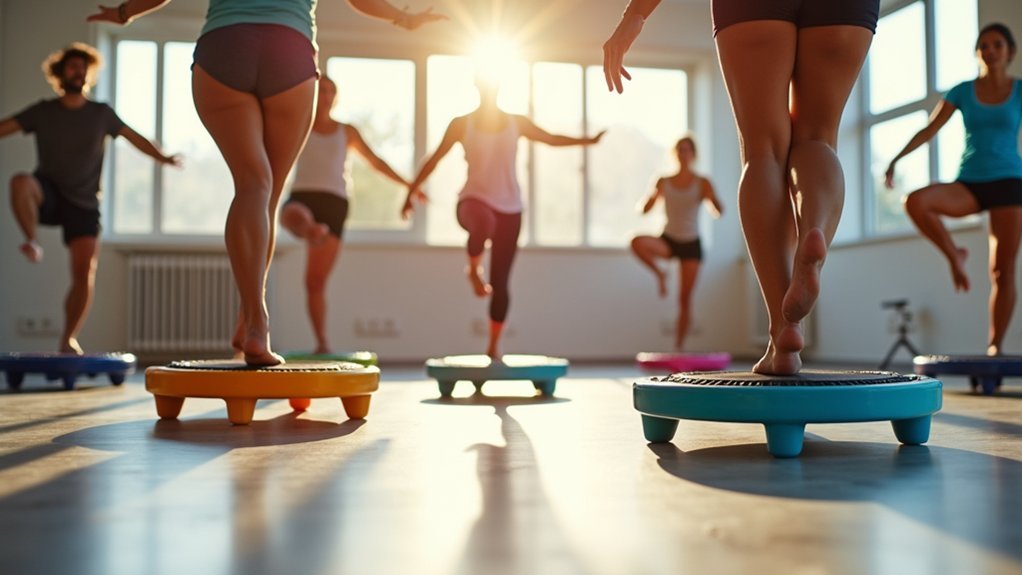
While many people view their mini rebounder primarily as a cardio tool, you’ll maximize its benefits by intentionally combining heart-pumping movements with balance challenges. This unique platform creates the perfect environment to boost your heart rate while simultaneously improving proprioception and stability.
- Try alternating between controlled knee-to-chest movements and quick bouncing intervals to engage your core and challenge stabilizing muscles.
- Incorporate straight leg kicks while maintaining your balance on the flexible surface for improved coordination.
- Add music to your routine to enhance motivation and performance during the most challenging balance exercises.
- Practice consistently to develop lower body strength and core stability that transfers to better balance in everyday activities.
Incorporating Balance Training Into Your Weekly Routine
To maximize the benefits of your rebounder, you’ll need to strategically incorporate balance training into your weekly exercise schedule rather than treating it as an occasional add-on. Commit to at least two or three balance-focused sessions weekly, featuring exercises like knee-to-chest lifts and straight leg extensions to the side and back.
| Day | Exercise Focus | Benefit |
|---|---|---|
| Mon | Slow movements | Core stability |
| Wed | Dynamic bouncing | Proprioception |
| Fri | Combined shifts | Total-body coordination |
Pair your workouts with music to keep sessions engaging and establish a consistent routine. The key to improvement lies in practicing specific moves regularly, challenging your stabilizing muscles to adapt. As you shift between slow and bouncing movements, you’ll develop the dynamic stability that translates to better balance in everyday life.
Frequently Asked Questions
Does Rebounding Improve Balance?
Yes, rebounding does improve your balance. You’ll strengthen core muscles and enhance proprioception as your body constantly adjusts to the unstable surface. It’s a safe, low-impact way to develop better stability.
What Is 10 Minutes on a Rebounder Equivalent To?
Ten minutes on a rebounder is equivalent to about 30 minutes of walking or jogging. You’ll burn roughly 50% more calories than traditional aerobic exercises while enjoying the benefits of improved lymphatic circulation and muscle toning.
How Long Does It Take to Rebound to Drain the Lymphatic System?
You’ll generally need 15-30 minutes of rebounding to effectively drain your lymphatic system. For ideal results, maintain a consistent routine several times weekly to enhance circulation and support your body’s natural detoxification process.
How Can I Improve My Trampoline Balance?
You’ll improve your trampoline balance by engaging your core muscles, practicing knee-to-chest lifts with leg kicks, and performing controlled movements before bouncing. Include side leg lifts and rear extensions while maintaining proper posture.
In Summary
You’ve now got everything you need to transform your mini rebounder into a balance-boosting powerhouse. Start with basic exercises and gradually challenge yourself as you progress. Remember, consistency is key—even 10-15 minutes three times weekly will greatly improve your stability. By combining core work, lower body movements, and progressive challenges, you’ll notice improved balance both on and off your rebounder.

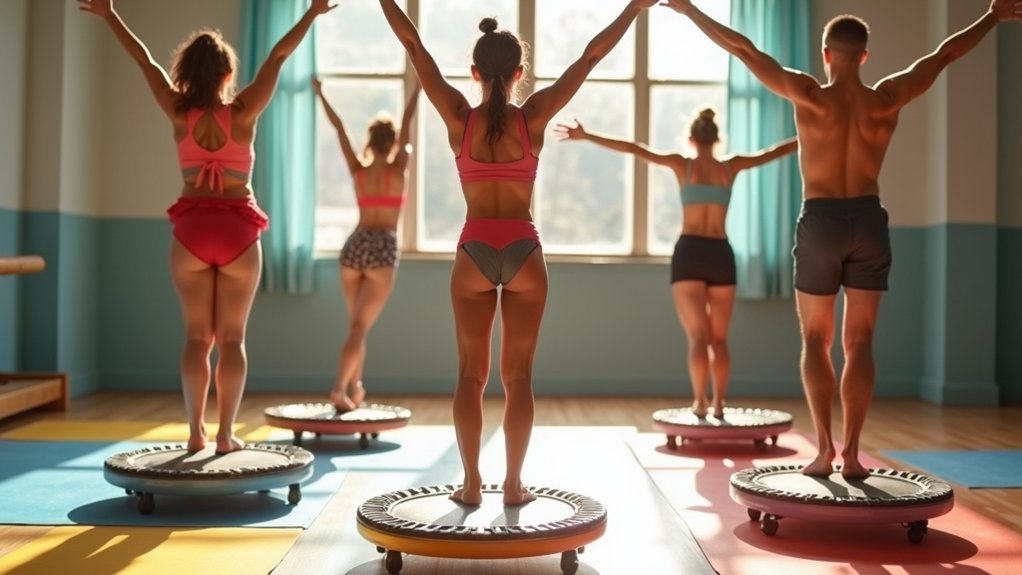

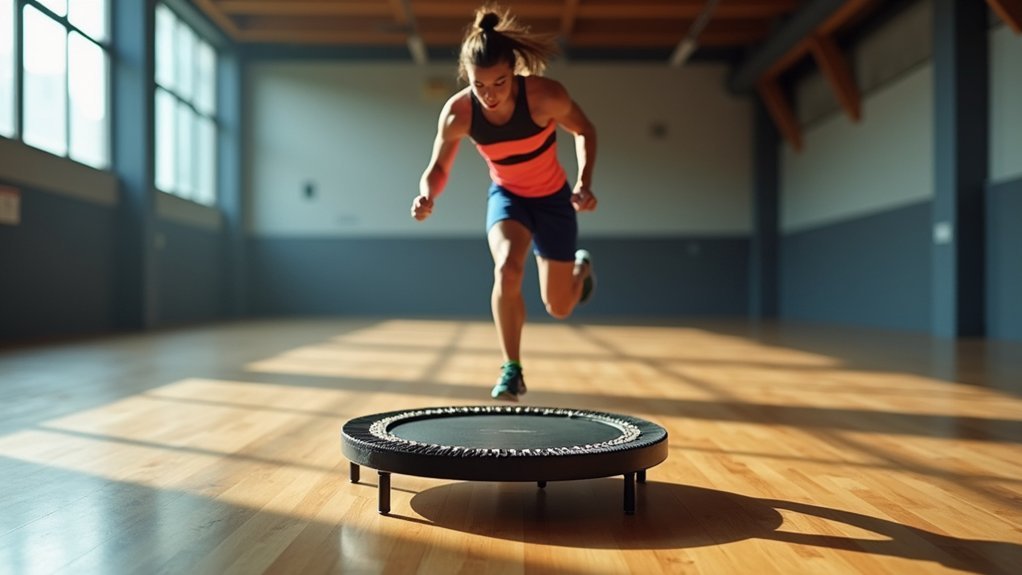
Leave a Reply